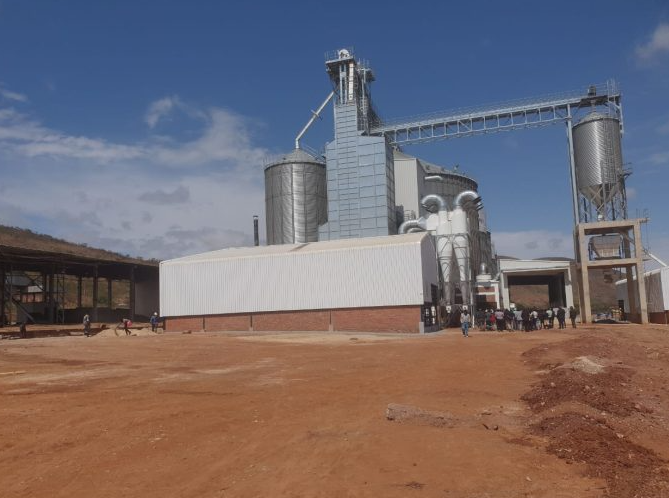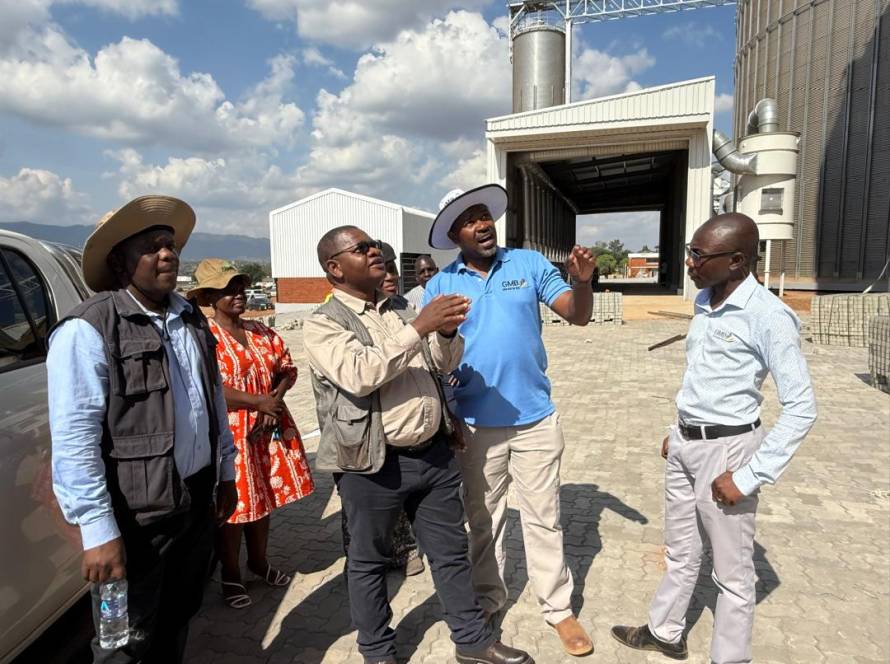Story by Richard Muponde - Zimpapers
THE Grain Marketing Board (GMB) has taken a significant step towards realising President Mnangagwa’s vision of leveraging technology and innovation for the development of Zimbabwe.
The construction of state-of-the-art Artificial Intelligence-powered grain silos in Kwekwe is a testament by the GMB to the Government’s commitment to technological advancement, aligning with the Vision 2030 of achieving an upper-middle-class economy.
The AI-powered silos in Kwekwe, with a storage capacity of 56 000 tonnes (7 silos x 8 000 tonnes each), will drastically reduce transportation costs for farmers in the region. Previously, farmers had to transport grain to silos in Chegutu, incurring costs exceeding US$600 to hire a 30-tonne truck. The new silos will not only reduce costs but also make storage more accessible, encouraging farmers to increase production.
The Kwekwe silos are part of a nationwide infrastructure drive by the Second Republic to bolster the country’s strategic grain reserves. The project includes the construction of 14 modern silo complexes in key agricultural zones such as Beitbridge, Gwanda, Lupane, Gokwe, Masvingo, and Timber Mills in Mutare.
Each silo complex, including Kwekwe, has a storage capacity of 8 000 tonnes, contributing to a targeted national silo capacity of 1,5 million tonnes, up from the current 750 000 tonnes. This expansion is critical to cushioning the country against droughts, stabilising food prices, and reducing post-harvest losses.
This project augurs well with the Government’s call for increased irrigation projects to mitigate the effects of climate change and build enough storage facilities. Zimbabwe aims to reclaim its status as the “Bread Basket of Africa” through advanced agricultural projects like this one.
The construction of similar grain silos in all the country’s provinces, with a targeted national silo capacity of 1.5 million tonnes, will help cushion the country against droughts, stabilise food prices, and reduce post-harvest losses.
In his remarks at the commissioning of the silos, President Mnangagwa numerous investments made under the Second Republic have put Zimbabwe firmly on course to becoming a food secure country.
“This particular infrastructure we are unveiling today is timely, more-so that the negative impacts of climate change have heightened the need for robust and holistic food security initiatives as well as sustainable food supply and nutrition,” President Mnagagwa said.
“Cognisant of this fact, my Government in 2020, launched the Agriculture, Food Systems and Rural Transformation Strategy towards guaranteeing food and nutrition security. The improvement of livelihoods and contribution to overall economic development is also at the core of this Strategy.”
The President highlighted that the country had witnessed increased production and productivity in cereals, horticulture, oil-seed crops, as well as other industrial crops, along with improved national livestock numbers.
“Additionally, the high impact of measures implemented by the Second Republic to improve resilience such as the Sustainable Intensive Conservation scheme Pfumvudza/Intwasa) Programme, among others, has restored food security at household level. In the midst of the worst drought in 43 years experienced last year, my Government was able, to distribute food to all vulnerable communities, in both rural and urban areas,” he said.
While GMB’s efforts in modernising storage facilities are commendable, there are other areas that the board needs to work on. One such area is the prompt disbursement of delivery payments to farmers.
Many at times farmers have raised concerns over late payment of grain delivery, which they say hinder adequate operations including preparations for each new season.
Zimbabwe National Farmers Union (ZNFU) president, Mrs Monica Chinamasa, said GMB need to expedite in the payment of farmers for grain delivered.
“They’ve got the facilities. Let them perfect their work on storage. But on payment, the Ministry of Agriculture must facilitate payment from Treasury to GMB so that farmers are paid on time,” said Mrs Chinamasa
“On payment modalities, GMB only passes on the money to the farmers. The money comes from Treasury. So Treasury is not playing ball. So far, some farmers are waiting for payment of wheat year last year in October. So that is how bad it is. Tobacco, no, we don’t want Government involved. Farmers work straight with the contractors because contractors bring the money from outside through RBZ and pay the farmers.”
Zimbabwe’s 2024/25 summer season plan was aimed at pushing up grain production to 3, 2 million tonnes compared with the 744 000 tonnes recorded in the previous season. The figure included 2.7 million tonnes of maize.
This has been attributed to consistent rainfall, which has ensured adequate moisture levels for crops and the successful containment of an armyworm outbreak leading in reduced threat to crops.
Zimbabwe was faced a severe El Niño-induced drought last season. The drought severely affected subsistence agriculture, which supports 70 percent of the population. Crop yields plummeted, and water reserves went to historic lows, creating a humanitarian crisis in rural communities.
A bumper harvest would significantly bolster Zimbabwe’s food security, reduce reliance on imports, and contribute to the national economy.
GMB’s initiative to build AI-powered grain silos is a welcome development, demonstrating the government’s commitment to technological advancement and food security.
However, addressing the issue of late payment to farmers is crucial to encourage continued production and increase uptake of grain farming, particularly through irrigation. By supporting farmers and investing in infrastructure, Zimbabwe can achieve its goal of becoming the “Bread Basket of Africa”.




